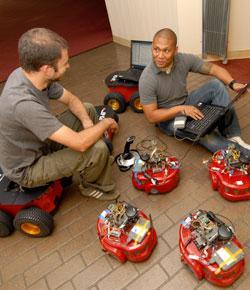The Robotics Lab:
Where Research, Partnerships, and Innovation Come Together
The SCU Robotics Systems Laboratory is always buzzing with activity. From designing and operating a shoe-box sized spacecraft, to analyzing the computerized diagnostics system of a top-of-the-line BMW automobile, students are involved in real-world engineering on a daily basis.
“We have a line of three Remotely Operated Vehicles, a student designed boat, a fleet of automated kayaks, multiple land rovers, remote-controlled planes, blimps, and spacecraft,” described Richard “Mike” Rasay ’01, ’07 MS, mechanical engineering Ph.D. candidate and Robotics Systems Lab research staff. “In most other universities, there are labs dedicated to one type of system. But we consider ourselves a field robotics program, creating systems for land, sea, air, and space … this approach allows for technology to be developed and leveraged across platforms, which helps students understand how to create systems that are modular and extensible.”
Students of all levels and engineering disciplines are welcome in the Robotics Systems Lab. “Graduate students serve as mentors, especially with the senior design projects where they simulate a real-world client environment with concrete requirements that dictate the direction of project development,” explained Rasay.
Along with the design and development activities that occur on campus, many students travel to places as far off as El Salvador and Kwajalein, in the Marshall Islands, to support NASA satellite missions or domestically to Lake Tahoe for geological research with peers from the University of Nevada, Reno. “Robotics systems are interdisciplinary by nature,” said Rasay. “So, students are always interacting with folks outside of their major or learning concepts outside of their field of study.”
Established collaborative relationships with various local and national leaders in the industry – NASA Ames and Marshall Centers, Monterey Bay Aquarium Research Institute (MBARI), Lockheed Martin, to name a few, and key partnerships with universities like Universidad Centroamericana, St. Louis University, University of Texas at Austin, University of Hawaii, and Milwaukee School of Engineering, provide students with ample opportunities for expanding their horizons.
All this combines to give students “a first-hand look at industry-grade engineering without ever having to venture outside the campus,” said Rasay. “The students who work in the lab, whether they realize it or not, are exposed to resources that require them to apply theoretical classroom concepts to real world applications that they will use for the rest of their working lives.”
